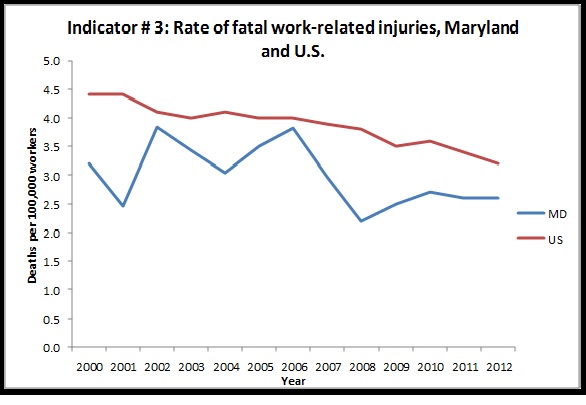Indicator #3: Fatal Work-Related Injuries

A fatal work-related injury is an injury occurring at work that results in death. Since 1992 the Bureau of Labor Statistics (BLS) has conducted the Census of Fatal Occupational Injuries (CFOI), using multiple data sources to provide complete counts of all fatal work-related injuries in the nation and in every state. CFOI includes fatalities resulting from non-intentional injuries such as falls, electrocutions, and acute poisonings as well as from motor vehicle crashes that occurred during travel for work. Also included are intentional injuries (i.e., homicides and suicides) that occurred at work. Fatalities that occur during a person’s commute to or from work are not counted.
Graph

Table
Indicator #3: Fatal Work-Related Injuries, Maryland
| Year | Number | Rate* |
|---|
| 2000 | 84 | 3.21 |
| 2001 | 64 | 2.45 |
| 2002 | 102 | 3.83 |
| 2003 | 92 | 3.44 |
| 2004 | 81 | 3.05 |
| 2005 | 95 | 3.51 |
| 2006 | 106 | 3.83 |
| 2007 | 82 | 2.98 |
| 2008 | 60 | 2.19 |
| 2009 | 65 | 2.47 |
| 2010 | 71 | 2.7 |
2011
| 71 | 2.6 |
2012
| 72 | 2.6 |
| 2013 | 79 | 2.8 |
| 2014 | 74 | 2.7 |
| 2015 | 69 | 2.4 |
| 2016 | 92 | 3.1 |
2017
| 87 | 3 |
| 2018 | 97 | 3.3 |
| 2019 | 78 | 2.6 |
| 2020 | 59 | 2.2 |
More about this Indicator
Why is this indicator important?
Multiple factors and risks contribute to work-related fatalities, including workplace/process design, work organization, worker characteristics, economics and other social factors. Surveillance of work-related fatalities can identify new hazards and case clusters, leading to the development of new interventions and development of new or revised regulations to protect workers.
Data Sources for this Indicator:
Census of Fatal Occupational Injuries (numbers of fatalities); Bureau of Labor Statistics Current Population Survey Data (employment statistics used to calculate rates).
U.S. data and information about this indicator obtained from http://www.cste.org/general/custom.asp?page=OHIndicators
Limitation of Indicator:
Census of Fatal Occupational Injuries (CFOI) program states are not permitted to release occupation or industry specific data when data are sparse. Such sparse data is categorized under ‘others’. The CFOI program, although it has a data element for ICD codes, publishes findings according to the OIIC classification system rather than ICD. Therefore, data from CFOI may not be comparable to causes of death documented on death certificates.

